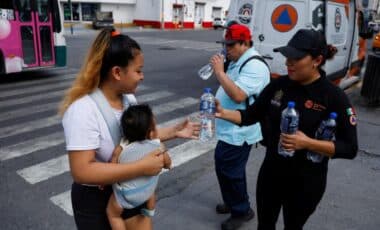The recent deadly heatwave that has affected large swaths of Mexico, Central America, and the southern United States was made 35 times more likely due to human-induced global heating, according to new research by leading climate scientists from World Weather Attribution (WWA).
The Scope of the Heatwave
In recent weeks, tens of millions of people have endured dangerously high temperatures as a heat dome—a large zone of high pressure—enveloped Mexico, stretching north to Texas, Arizona, and Nevada, and south over Belize, Honduras, Guatemala, and El Salvador.

This heat dome trapped hot air close to the ground, preventing cooler air from entering the region and causing temperatures to remain high for extended periods. In May and early June, the heat dome led to numerous daily and national temperature records being broken, resulting in widespread misery and disruption, particularly among the poorest and most marginalized communities.
According to the WWA analysis, such extreme heat spells are four times more likely today than they were at the turn of the millennium when the planet was 0.5°C cooler. “Unsurprisingly, heatwaves are getting deadlier,” said Friederike Otto, co-author of the study and senior lecturer in climate science at the Grantham Institute, Imperial College London. She added, “We’ve known about the dangers of climate change at least since the 1970s. But thanks to spineless politicians, who give in to fossil-fuel lobbying again and again, the world continues to burn huge amounts of oil, gas, and coal.”
Impact on Health and Infrastructure
Extremely hot weather significantly increases the rates of cardiovascular, respiratory, and renal diseases and threatens to overwhelm power supplies, healthcare facilities, and other critical infrastructure. In Mexico, at least 125 people have died, and thousands more have suffered from heatstroke since March, with temperatures reaching nearly 52°C on June 13, the hottest June day ever recorded in the country.
The severe heat has exacerbated drought and air pollution, caused power outages, water shortages, thousands of wildfires, and a mass die-off of endangered species. The full extent of the mortality and morbidity caused by the heatwave is still unknown, with many deaths likely to go unreported or confirmed only months after the event.
In the United States, Phoenix, the hottest major city, has been particularly affected. By June 8, the Maricopa County medical examiner's office was investigating 72 suspected heat deaths, an 18% increase compared to the same period last year. Across the southwestern US, more than 34 million people were under heat warnings, with dozens suffering from heat exhaustion at political rallies. "It's an oven here. You can't stay here," said 82-year-old Margarita Salazar Perez from Veracruz, Mexico, reflecting the dire conditions faced by many without access to adequate cooling.
How Climate Change Intensifies Deadly Heatwaves
To understand the effect of human-caused warming on the recent extreme temperatures across North and Central America, the WWA team of international scientists analyzed weather data and climate models. They used peer-reviewed methods to compare today's climate, with approximately 1.2°C of global warming, to the cooler pre-industrial climate. Their analysis found that the climate crisis made the excessive heat spell about 1.4°C hotter during the day and 35 times more likely than in pre-industrial times.
The effect on night temperatures is even more pronounced, with the analysis finding temperatures about 1.6°C hotter—a 200-fold increase due to global heating. Hot nights are particularly dangerous for human health, as the impact of heat is cumulative, and the body only begins to rest and recover when temperatures drop below 27°C (80°F).
WWA's research highlights the drastic changes in heatwave patterns. “As long as humans fill the atmosphere with fossil-fuel emissions, the heat will only get worse—vulnerable people will continue to die and the cost of living will continue to increase,” warned Izidine Pinto, co-author and researcher at the Royal Netherlands Meteorological Institute.




